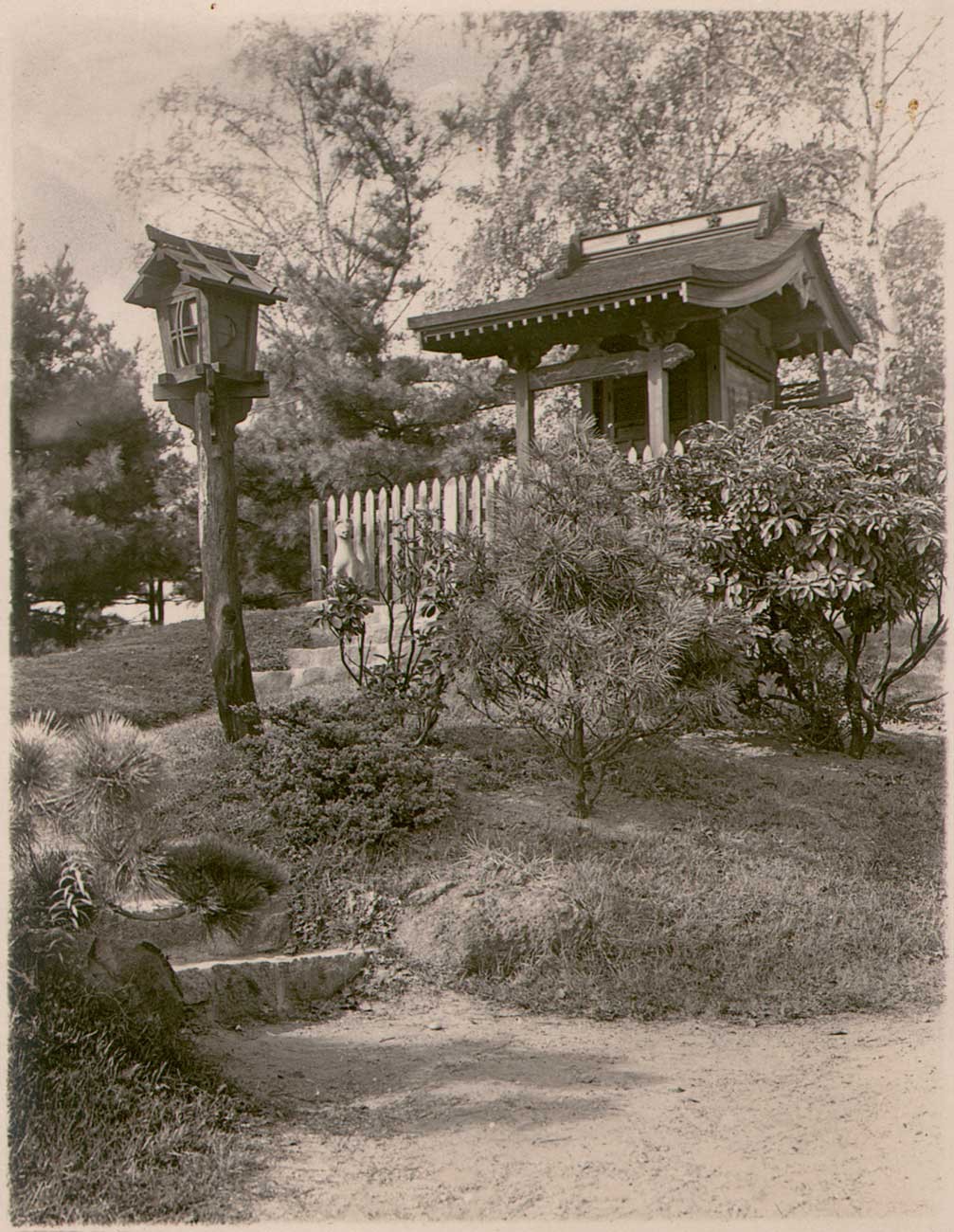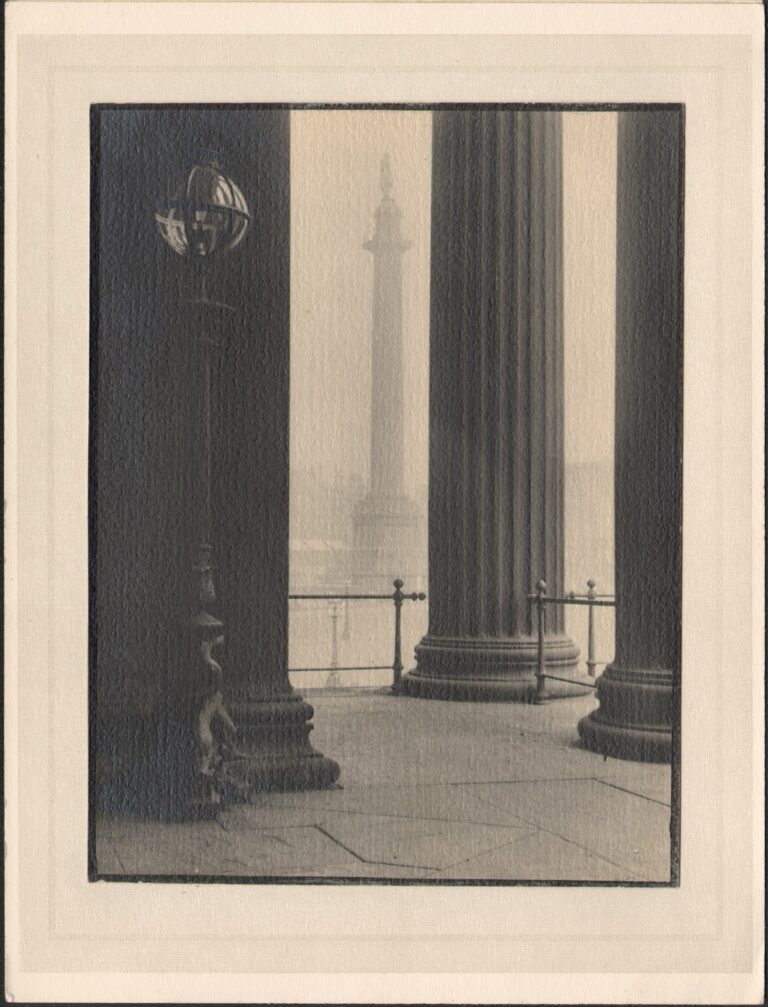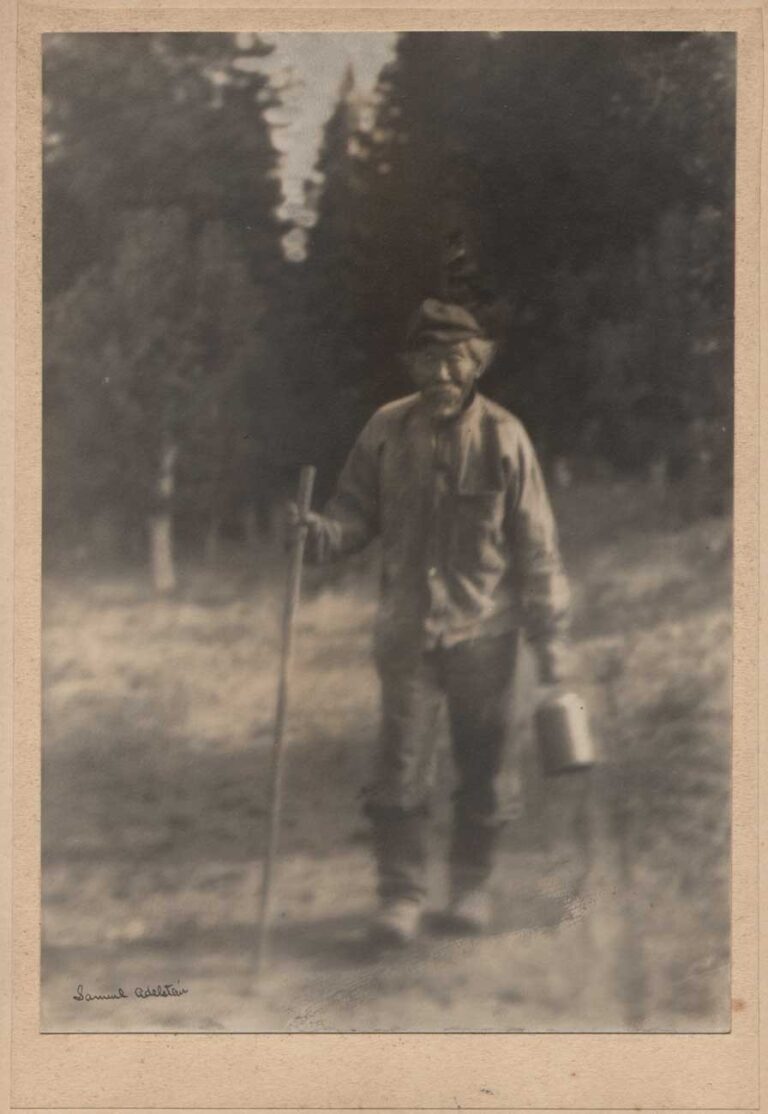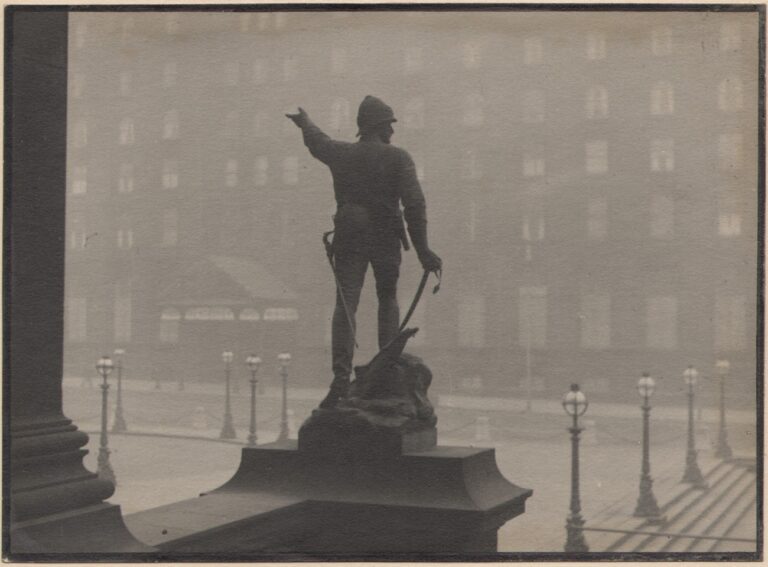
Shinto Shrine at Japanese Hill-and-Pond Garden
Dedicated to Inari, the Shinto God of the Harvest, is the shrine seen in this photograph, believed to have been taken in the early 1920’s, and located on a hillside in the Japanese Hill-and-Pond Garden at Brooklyn Botanic Garden. One of two pole-mounted wood lanterns original to the site can be seen on the left side of photo. This century-old Japanese garden is described thus by the Garden’s website:
The Japanese Hill-and-Pond Garden is one of the oldest and most visited Japanese-inspired gardens outside Japan. It is a blend of the ancient hill-and-pond style and the more recent stroll-garden style, in which various landscape features are gradually revealed along winding paths. The garden features artificial hills contoured around a pond, a waterfall, and an island while carefully placed rocks also play a leading role. Among the major architectural elements of the garden are wooden bridges, stone lanterns, a viewing pavilion, the torii or gateway, and a Shinto shrine.
The Japanese Hill-and-Pond Garden was the first Japanese garden to be created in an American public garden. It was constructed in 1914 and 1915—at an initial cost of $13,000, a gift of early BBG benefactor and trustee Alfred T. White—and it first opened to the public in June 1915. It is considered to be the masterpiece of its creator, Japanese landscape designer Takeo Shiota (1881–1943). Shiota was born in a small village about 40 miles from Tokyo, and in his youth spent years traversing Japan on foot to explore the natural landscape. In 1907 he came to America, driven by an ambition to create, in his words, “a garden more beautiful than all others in the world.” (1.)
Was Arson Responsible?
A sad chapter in U.S. history: anti-Japanese sentiment shown American citizens of Japanese ancestry by the Federal Government’s internment of 120,000 citizens in ten camps during World War II may have also been held by someone familiar with the garden harboring nativist leanings before America even declared war on Japan. Before the 1941 bombing of Pearl Harbor, the Brooklyn garden’s Shinto shrine mysteriously burned to the ground in January, 1938.
To their great credit, the garden’s website acknowledges this fact: “In 1938 its shrine was burned down, and the garden was closed for a time due to public antipathy to Japan.” An oversight? The garden’s designer, Takeo Shiota, (b. 1881) was interned in one of the aforementioned U.S. camps located in South Carolina and died there before the end of the war on December 3, 1943. New York Times correspondent Anne Raver, writing in 2000 about a yearlong $3 million renovation of the garden, did make note of this fact however :
Takeo Shiota died on Dec. 3, 1943, in a Japanese internment camp in South Carolina. And as his greatest work reopens this week, we think of him among the pines. (2.)
The fire which destroyed the Shinto shrine on January 25, 1938 also made news in the Times on January 26, with the headline:
“JAPANESE SHRINE IS RAZED BY FIRE; Enemy of Nation Suspected of Destroying Shinto Temple in Brooklyn Botanic Garden“.
The following article in full gives the details:
The Shinto shrine in the Japanese garden of the Brooklyn Botanic Garden was razed at noon yesterday by fire of undetermined origin. Though police reported nothing suspicious about the fire, Dr. C. Stuart Gager, director of the Botanic Garden, was inclined to be skeptical.
Investigation by the Fire Department disclosed that park workmen had been burning brush about 150 feet from the Japanese garden. Although not definitely established, it was believed that a burning ember was blown to the wooden roof of the shrine. Because of the heavy rain of yesterday and the day before, however, Dr. Gager was not convinced the fire was an accident. The suggestion was advanced that the fire was started by some one of anti-Japanese sentiments, though the Japanese garden has been closed to the public for the Winter.
The shrine in the Japanese garden was considered one of the beauty spots in the Botanic Garden and each year since it was opened to the public in 1915 had attracted thousands of visitors and photographers. The garden includes a small, odd-shaped lake, crossed by narrow bridges.
Costing $2000, the shrine was a copy of a Japanese structure dedicated to Inaria-Myojin,(sic) the god of harvest. Four upright posts, made of California redwood, supported the wooden shingled roof. In front stood two “sacred foxes,” carved from stone, which were unharmed by the fire.
The fire alarm was turned in by Peter Tully, a park employee in charge of the brush burning. Firemen under Battalion Chief Peter McKenzie put out the flames in a half hour, but first they had to connect up several hundred feet of hose in order to run it from Washington Avenue and around the garden lake to the shrine. (3.)
The fire also made front-page news for the afternoon edition of the Brooklyn Daily Eagle of January 25, 1938. The article link is here.
In 1960, the Shinto shrine was rebuilt by garden staff members and rededicated, and can still be seen at the garden in the present day.
This photograph, with title supplied by this archive, is by an Unknown Brooklyn amateur photographer whose surviving work was discovered in a trunk in the American South and acquired by PhotoSeed. Background can be found at link on Associated Blog Posts within this page.
1. excerpt: Overview & History: Japanese Hill-and-Pond Garden: Brooklyn Botanic Garden online resource accessed November, 2015.
2. Anne Raver: HUMAN NATURE; Revealing a Japanese Garden As Serene Melting Pot: in: The New York Times: May 18, 2000
3. p. 42



